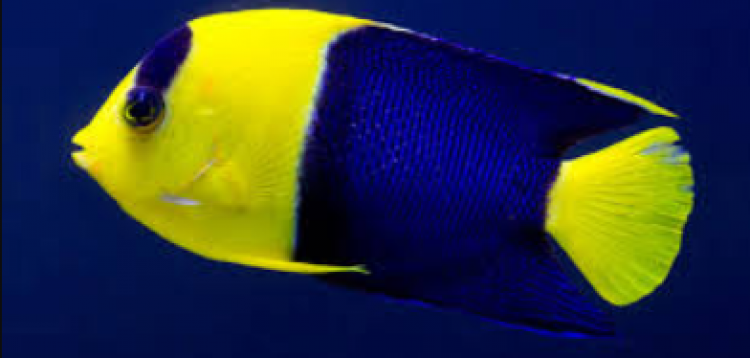- Name:
Koran Angelfish
(View AKA's) - Family: Pomacanthidae
- Species: Angel Large
- Scientific Name: Pomacanthus semicirculatus


General info about Koran Angelfish
The Koran Angelfish is an extremely popular and hardy angelfish. As an adult, the body color is yellow-green that blends from light to dark moving front to back along the body. Lighter areas are speckled-blue while darker areas have a more yellow-speckled appearance. The head is a plain yellow-green with sapphire-blue gill margins and eye rings. The fins are also outlined in sapphire blue. The juvenile is black with white and blue stripes. The Koran Angelfish requires a large tank with large amounts of live rock for hiding and grazing upon slime algae and cyanobacteria. It is prone to nip at stony and soft corals (sessile invertebrates) and clam mantles so it is not a good candidate for a reef aquarium.
Koran Angelfish Diet & Nutrition
Koran angelfish are omnivores that feed on a variety of sponge, tunicates, algae, and other encrusting animals in the wild. In captivity, they can be fed with all kinds of live, frozen, and prepared formula food. It is essential to include vegetable based food in their diet as well as meaty fare like chopped squid, scallop and shrimp. Prepared food with marine sponge as an ingredient is also essential.
This angelfish should be fed 3 or more times a day.
Determining Sex of Koran Angelfish
There is no clear evidence of sexual dimorphism for the Koran angelfish. However based on observations, the length of the opercular spine offers an indication of sex, males having the longer and more pointed spines than the females. It has also been observed that females tend to have a swollen belly when fertile and that males are larger and paler compared to the females.
Breeding & Spawning Koran Angelfish
Spawning may occur in captivity, however, breeding the larvae in captivity is difficult. The Koran angelfish are broadcast spawners releasing their eggs at dusk. Courting behavior are usually seen when they rise above the water column and release their gametes. The fertilized eggs will float in planktonic stage for a few weeks, eventually settling at the bottom apart from their parents.
Common Diseases with Koran Angelfish
Koran angelfish are quite sensitive to water quality and may develop infectious diseases, such as White Spot disease and Velvet disease, and parasites from live rocks in the tank.
Koran Angelfish Origin
Koran angelfish are found in the Indo-Pacific region with ranges from the east coast of Africa to Fiji and Japan, the east coast of Australia and New Caledonia.
Caution with Koran Angelfish
Koran angels are very territorial, thus it is best to keep only one individual from the species in the aquarium. Juvenile Koran angelfish may chase and nip at butterflyfish and rabbitfish that are smaller or similar in size. Juveniles are also known to nip at stony corals with large polyps, soft corals, and clams.
In order to keep with other angelfish or fish in general, tank size must be a minimum of 180 gallon and that species should have different coloration as possible. The presences of a few live rocks are recommended to continue the normal grazing behavior of Koran angelfish in captivity.
Acclimating Koran Angelfish
It is recommended that Koran angelfish should be introduced in tanks with well decorated rocks that are at least 6 months old. A minimum size of 135 gallons is suggested, with between 225 to 275 gallons for adults and pairs.
Water conditions for the Koran angelfish should be kept as follows: pH of 8.1 to 8.4, specific gravity of 1.019 to 1.025 and a water temperature of 74 to 82.
Original Detail
| Name | Species | Family | Scientific Name | More Detail | Added by |
|---|---|---|---|---|---|
| Koran Angelfish | Angel Large | Pomacanthidae | Pomacanthus semicirculatus | The Koran Angelfish is an extremely popular and hardy angelfish. As an adult, the body color is yellow-green that blends from light to dark moving front to back along the body. Lighter areas are speckled-blue while darker areas have a more yellow-speckled appearance. The head is a plain yellow-green with sapphire-blue gill margins and eye rings. The fins are also outlined in sapphire blue. The juvenile is black with white and blue stripes. The Koran Angelfish requires a large tank with large amounts of live rock for hiding and grazing upon slime algae and cyanobacteria. It is prone to nip at stony and soft corals (sessile invertebrates) and clam mantles so it is not a good candidate for a reef aquarium. |
PalaciosAn |
Changed by users
| Submitted Date | Submitted By | Status | Action |
|---|



